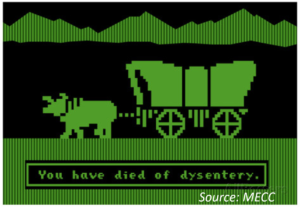Finding Community on Twitter: Why I Plugged In

I have to admit, I originally thought Twitter was a useless place full of what [crazy thing] that [pop star i don’t care about] did ten minutes ago combined with destructive ramblings by internet trolls. Full GenX disclosure: I remember when the internet wasn’t a thing and using floppy disks to play Oregon Trail was cool. BTW, everyone should experience the dissatisfaction of finally successfully hunting an 894 pound bear just to be told they can only carry 100 pounds of virtual food back to their dysentery-stricken family. Creative OT epitaphs were my jam.

I got started on Twitter at the recommendation of a senior colleague whose invaluable career advice I deeply appreciate. While Twitter as an infotainment source or soap-box never resonated with me, it made more sense when I viewed it as a professional forum. I’ve come to realize it’s an excellent way to:
- Keep up with scientific advances
- Promote the science of my colleagues (or occasionally myself)
- Seek real-time feedback/information (new ideas, conference happenings, etc.)
- Interact with colleagues in a “hallway chat” kind of way
This last use case was the impetus for this blog post, as we’re all grappling with ways to retain a sense of community following our recent thrust into virtual communication. Now more than ever, I get a charge out of seeing posts from my Vanderbilt “family.” Especially the ones where they let their hair down a little and leave a few Easter eggs of their personal life cleverly nestled in there.
So how do you start?
- Make a profile. Add *opinions are all my own* or similar disclosure to your bio so your institution’s social media police don’t get you.
- Search for and follow people and groups you know (your institution’s name is a good first search). This is also a good way to build followers. Note: following someone doesn’t require they accept your invitation like LinkedIn or Facebook, so keep that in mind.
- Learn the “rules” from a Twitter pro (aka not me), ideally someone you know IRL so you can see how their personality comes through online. Pro-tip: aim for the right curation/creation ratio, likely 20% or less creation. This was key for me, as I’m much more comfortable promoting others (curation) than myself (creation). It’s ok to sit on the sidelines for a while to get the lay of the land before you dive in and start tweeting/re-tweeting.
- Check out these blog posts for more science Twitter how-to:
https://edgeforscholars.org/professional-success-in-social-media/
https://edgeforscholars.org/improve-tweets-using-healthcare-hashtags/
5. Check out this Nature article for more Science Twitter guidance: https://www.nature.com/articles/d41586-019-00535-w
6. Start re-tweeting and commenting on posts from your colleagues. Ease into posting your own content, ideally with images included.
If now isn’t the time for you to embark on a Twitter experiment, I hope you continue to find community engagement in whatever ways work for you. Happy hour by Zoom? Old school phone call?
Let me be clear: I am still pretty new to Twitter myself and am unlikely to ever reach influencer status, so if you have additional tips or (gasp) corrections, please share in the comments section!
More Resources
Conversion of a Social Media Skeptic
Professional Success in Social Media
Not that Kind of Network: Tales of Developing a National Reputation






1 Comment
Add *opinions are all my own*
They can still get you.